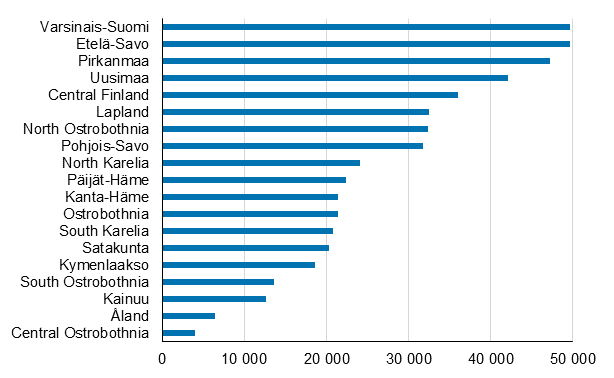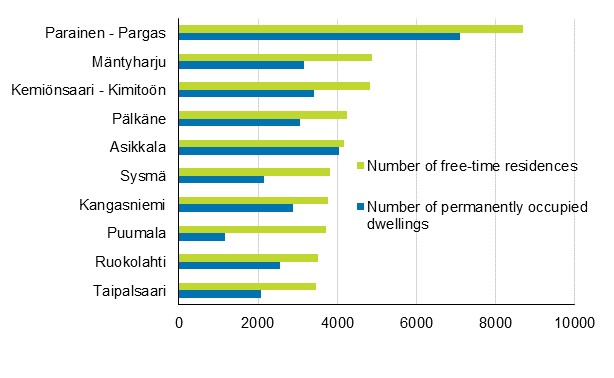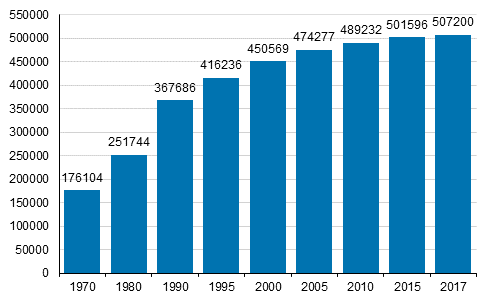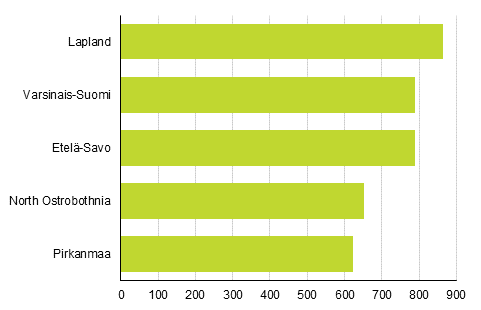Free-time Residences 2017
Kuopio had the highest number of free-time residences in 2017
According to Statistics Finland, there were over half a million free-time residences in Finland in 2017. At the same time, Kuopio was the biggest municipality in Finland by its number of free-time residences. Mikkeli was the second biggest municipality measured by the number of free-time residences in 2017. Both Kuopio and Mikkeli have more than 10,000 free-time residences.
Table 1. Municipalities with highest number of free-time residences in 2017
| Regional Division based on Municipalities on 1 Jan. 2018 | Number of free-time residences | |
| 1. | Kuopio | 10 789 |
| 2. | Mikkeli | 10 444 |
| 3. | Parainen | 8 695 |
| 4. | Lohja | 8 468 |
| 5. | Savonlinna | 8 416 |
| 6. | Hämeenlinna | 8 043 |
| 7. | Kouvola | 7 749 |
| 8. | Salo | 7 065 |
| 9. | Kuusamo | 6 837 |
| 10. | Raasepori | 6 598 |
| 11. | Pori | 5 195 |
| 12. | Mäntyharju | 4 868 |
| 13. | Kemiönsaari | 4 817 |
| 14. | Kangasala | 4 647 |
| 15. | Naantali | 4 646 |
Varsinais-Suomi was the region with the highest number of free-time residences in 2017, around 49,700 free time residences. The number of free-time residences also exceeded 47,000 in the regions of Etelä-Savo and Pirkanmaa. The regions of Central Ostrobothnia (4,000 free time residences) and Åland (6,500 free time residences) had the lowest numbers of free-time residences.
Figure 1. Number of free-time residences by region in 2017

The density of free-time residences in the municipality can also be described by comparing their number with that of permanently occupied dwellings. Then the municipalities richest in free-time residences were places that had a relatively low number of population and a high number of free-time residences. At the end of 2017, altogether 65 municipalities had more free-time residences than permanently occupied dwellings. Such municipalities were Parainen, Mäntyharju, Kemiönsaari and Pälkäne. As the number of permanent residents decreases, the number of free-time residences may become emphasised in ever more municipalities. From 2000 onwards, the number of municipalities with a majority of free-time residences has increased approximately by thirty, when the situation is viewed with the present division of municipalities of 2018.
Figure 2. Municipalities with more free-time residences than occupied dwellings in 2017 (those with the highest number of free-time residences)

Stock of free-time residences grew most in the 1980s
There were 507,200 free-time residences in Finland at the end of 2017. The number increased by 4,300 from the previous year. The stock of free-time residences does not grow direct due to newbuilding because some free-time residences area converted into permanent dwellings or their active use is discontinued. The number of free-time residences grew fastest in the 1980s. In 1990, there were 368,000 free-time residences, which was 46 per cent more than in 1980. From 1970 to 1980, the increase was 75,600, or 43 per cent.
Figure 3. Number of free-time residences in 1970 to 2017

The rate of construction of free-time residences has been slowing down steadily since the early years of the 1990s. Whereas roughly 8,000 free-time residences were built every year in the early 1990s, in recent years the number has been 2,000–3,000 free-time residences per year. Through the 1990s, the stock of free-time residences grew by around 20 per cent. This is clearly by less than in the 1970s and 1980s, when the stock increased by over 40 per cent per decade.
Altogether 2,000–3,000 new free-time residences completed per year
Over 4,000 new free-time residential buildings have been completed per year in the 2000s. Nowadays they are completed less and less free-time residences per year. For example a few thousands new free-time residential buildings were completed in 2017 (according to statistics of buildingstock).
During 2017, the highest numbers of new free-time residences were built in Lapland, Etelä-Savo and Varsinais-Suomi. By municipality, the highest numbers of new free-time residences were built in Kuusamo, Kittilä, Savonlinna, and Kolari: over 40 free-time residences in the year in each municipality.Figure 4. Regions with highest numbers of new free-time residences built between 2015 and 2017

Building of free-time residences liveliest in Lapland, Etelä-Savo and Varsinais-Suomi
In the 2000s, the highest numbers of free-time residential buildings have been completed in general in Lapland, Etelä-Savo and Varsinais-Suomi, where their number has grown by over 400 per year.
Since 1990 the stock of free-time residences has grown most in Etelä-Savo, where it has increased by approximately 14,500. The stock has changed least in Central Ostrobothnia and Åland where the number of free-time residences has increased by over 1,500 since 1990.
Summer residences densest in Kustavi and Kaskinen
Free-time residences are densest in the municipality of Kustavi and Kaskinen with average 15–18 free-time residences per square kilometre of land. In eight municipalities there are more than ten free-time residences per square kilometre. In the whole country there are, on the average, 1,7 free-time residences per square kilometre. Varsinais-Suomi, Uusimaa, Päijät-Häme, Kanta-Häme and Åland have more than four free-time residences per square kilometre. In North and Central Ostrobothnia, and Kainuu and Lapland there is average less than one free-time residence per square kilometre. In proportion to the land area, Kauniainen, Savukoski, Enontekiö and Utsjoki have the lowest number of free-time residences.
Average size of free-time residences 49 square metres
New free-time residences are larger in floor area than before. The average floor area of free-time residences built in the 2010s was 71 square metres and the median 65 square metres. The average floor area of free-time residences built in 2000 to 2009 was 65 square metres and the median 56 square metres. The average floor of all free-time residences was 49 square metres in 2017. The known square metres of free-time residences are included in the average floor size (the floor area of around 16,000 free-time residences is unknown). Large free-time residences and buildings used as leisure-time housing increased the average size to some extent, as the median floor area of all free-time residences was 40 square metres. Thus, one-half of free-time residences still have a floor area of 40 square metres or less. The share of large free-time residences with a floor area of at least 60 square metres was 26 per cent of all free-time residences in 2017. In 1970, the share of such large free-time residences in the stock of free-time residences was 15 per cent.
Table 2. Free-time residences by floor area in 2017
| Floor area, m2 | Number of free-time residences | % |
| Free-time residences, total | 507 200 | 100,0 |
| – 19 | 45 432 | 9,0 |
| 20 – 39 | 180 539 | 35,6 |
| 40 – 59 | 136 763 | 27,0 |
| 60 – 79 | 65 695 | 13,0 |
| 80 – 99 | 31 572 | 6,2 |
| 100 – | 30 976 | 6,1 |
| Unknown | 16 223 | 3,2 |
| Average floor space | 49 | |
| Median floor space | 42 |
Nearly 819,000 Finns belong to a household-dwelling unit with a free-time residence
Of all free-time residences, 431,000 were owned by private persons. Around 76,000 free-time residences were owned by heirs, companies, communities or foreigners. In all, almost 819,000 persons belonged to a household-dwelling unit that owned a free-time residence. In many municipalities, summer residents double the population of the municipality in summer.
Free-time residences are usually located near the owner’s permanent residence. In total, 64 per cent of free-time residence owners had a free-time residence in their region of residence. More than 90 per cent of free-time residence owners in Åland, Lapland and North Karelia owned a free-time residence in the region of residence. By contrast, the free-time residences of persons residing in Uusimaa were mainly located in some other region. Only 29 per cent of Uusimaa residents owned free-time residences in Uusimaa. One-third of all free-time residence owners had a free-time residence in their municipality of domicile.
Average age of free-time residence owners is 62 years
The average age of the owners of new free-time residences completed in 2017 was 54 years, while the average age of all owners of free-time residences was 62 years in 2017. Around 24,000, or only six per cent of all free-time residence owners were aged under 40.
Of all free-time residences, almost 40 per cent were owned by a household-dwelling units of two adults and 12 per cent by households with children aged under 18. Sixteen per cent of free-time residences were owned by single-person households and 15 per cent by heirs, companies, communities or the owner was unknown. 60 per cent of the owners of free-time residences lived in detached or semi-detached houses.
Median distance to the free-time residence is 38 kilometres
The average distance between one's home and free-time residence was 91 kilometres and the median was 38 kilometres. Therefore, one-half of journeys to free-time residences were at most 38 kilometres. The median for the journey of those living in Uusimaa to their free-time residences was 130 kilometres and the average 166 kilometres. The median of the journey of people living in Uusimaa to their free-time residences was over three times longer than the median for the entire country and the average nearly double compared with the average for the whole country. The median for the journey of those living elsewhere than in Uusimaa to their free-time residences was 26 kilometres and the average 63 kilometres.
The journey to a free-time residence was calculated for free-time residences owned by private persons. A journey to a free-time residence refers to the linear distance between the permanent residence and free-time residence of the free-time residence owner. In 2017, the distance could be calculated for 84 per cent of the whole stock of free-time residences.
Source: Buildings and Free-time Residences, Statistics Finland
Inquiries: Otto Kannisto 029 551 3044, Marja Hermiö 029 551 3211, info@stat.fi
Director in charge: Jari Tarkoma
Updated 25.5.2018
Official Statistics of Finland (OSF):
Buildings and free-time residences [e-publication].
ISSN=1798-6796. 2017,
Free-time Residences 2017
. Helsinki: Statistics Finland [referred: 19.4.2025].
Access method: http://stat.fi/til/rakke/2017/rakke_2017_2018-05-25_kat_001_en.html

